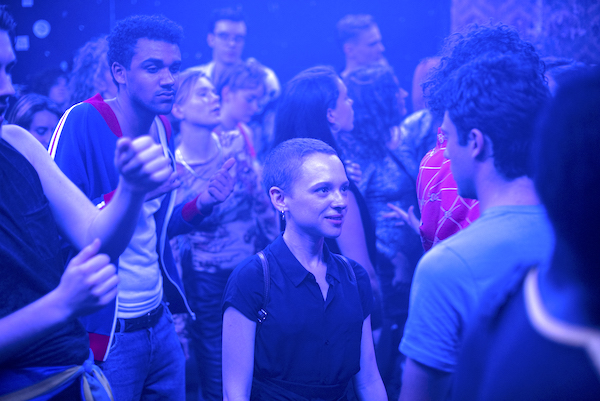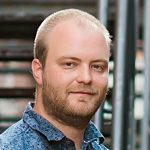Anna Winger has done a little bit of everything. She got her start in photography, where she did some commercial work and some documentary work, but across the board, if you have to summarize her career, she’s a storyteller at heart.
“It happened by chance that I became a screenwriter,” she confessed. Previously, she traveled for work, but when she had children, she wanted to do something from home, which led to her first novel, 2008’s This Must Be the Place.
“I spent four years writing a novel. It was the first thing I ever wrote,” she said. “I really enjoyed the process, but it was quite isolating. Photography is a lot like showrunning – casting, locations, costume – like a three-ring circus.”
After she finished the novel, her TV producer husband Joerg Winger suggested she also write a screenplay. She was somewhat hesitant, disregarding this suggestion the first few times, but then she had the idea for Deutschland. Her husband liked the general idea and told her that if she wrote it, he would produce it. “That was my first TV show.”
Winger said her husband helped her navigate the waters of her first screenplay. “I’m American and I live in Germany, so there wasn’t the option of taking a class, so he was instrumental in explaining the basics.” In addition to the fundamentals, Winger’s husband also told her to “trust that [she] had absorbed a lot of it intuitively already, because we watched so much TV together and because we were movie buffs.”

Anna Winger
That said, she also majored in Film at Columbia University, so she had a deep understanding of film before she moved into photography. Deutschland was the culmination of everything she had learned and created, leading up its release in 2015. “I had never written anything until I had children. I never wrote a screenplay before I was 40.” Anna Winger also wrote Winger Deutschland 83, Deutschland 86, Deutschland 89, and the current Netflix series, Unorthodox.
From Photos to Written Words
“It felt like a continuation of something I was really doing,” said Winger about her transition from photography to novels. “What you would call a photographer’s vision was similar to my voice as a screenwriter.”
Specifically, she was interested in documentary subjects, other cultures, new locations, and anything that could be turned into a story, which she called “learning through taking pictures.”
“But there was also some humor in my pictures – a kind of curiosity. I liked them to be a little bit messy. And, when I started to write, I felt like it came from the same place. It felt organic.” The difference, of course, is the time spent in solitude, particularly with novels, but also with spec scripts.
She also found the subtraction of stages somewhat difficult, since novel writing is essentially a straight grind, where photography and filmmaking have planning, writing, shooting, and editing phases. “The stretch of writing a novel – 6 months to a year – there is no other part of it.”
“The voice part and the storytelling felt organic, but the process was different. With a novel, it’s you and the computer and it’s over. With a script, there are all these different parts of it, similar to photography projects and commercials. I missed [that process], but I found it again in screenwriting.”
Her book actually involved the filmmaking industry within the plot. Germans are known for their dubbing and an actor in Germany will dub the same American his entire life (her fish-out-of-water character was Tom Cruise’s dubbed German voice). “Sometimes, people see my work and read my projects and they say, ‘It sounds like you,’ which is nice. But I haven’t read it again since it was published. I think it’s charming that people say that.”
Misconceptions About Screenwriting
From books to TV pilots to running her own TV writers’ room, some of the advice her husband gave her is now advice she passes on to others. One example, “Structure is your friend.”
“I think there’s an idea that to be artistic, there should be no infrastructure or no plan. The surprise for me – looking at films and TV episodes I loved – was to see there was a structure in them and it wasn’t necessarily that different from one to the next. The structure allowed the writer to hang all the things that interested them. And, once there was this dramaturgical propulsion built-in through the structure, then they had creative freedom.”
Anna Winger felt freedom and security from the new format, given that novels and photography have less structure. “Movie and episodic television, especially horizontal storytelling, have a scaffolding build in.”
At first, the screenwriter followed many novice writer’s pursuits, assuming her story would be “too radical” for any type of structure. But, when she examined her favorites once again, she realized the scaffolding served a purpose.

Yanky Shapiro (Amit Rahav) & Esther Shapiro (Shira Haas) in Unorthodox. Photo by Anika Molnar/Netflix
In the TV writers’ room and in her role as an executive producer on other shows, she finds many writers resist the structure. “They see it as a limitation, but I see it as liberating. Some things become very messy very quickly, and then the creativity gets bogged down by that mess.”
The structure is particularly useful amongst the room of writers, where the decision making is a collective process. “You’re in dialogue with other people as you’re writing and the structure gives you a tool to talk about the work. I find that very useful in my collaborations.”
Winger’s Storytelling Criteria
“I’m really interested in stuff that hooks me, or resonates with me, but where I don’t know everything about the subject. Of course, I relate to characters in ways that might not be visible to the outside world.”
She clarified, “I’ve never been a Stasi agent or a Hasidic bride, but I relate to that curiosity about the world, the fish-out-of-water story. I’m drawn to narratives where I relate in some way, but also where they’re set in very specific places and context. I also love news and history.”
As an American living in Germany, she was actually a fish-out-of-water most of her life. When she met Deborah Feldman, another mom where her kids went to school, the two got to talk about Feldman’s memoir, Unorthodox: The Scandalous Rejection of My Hasidic Roots.
“We got to know each other privately, I read the book and loved it. At some point in our friendship, she said, ‘Why don’t you make a TV show out of my book?’ I had never worked from existing material before, so it was challenging. A memoir is so much in her mind, it was hard for me to see it.”
Feldman told Winger she didn’t mind if they changed or “broke it apart to build something new out of it,” given that books and screenplays are quite different.
The Story of Unorthodox
Around the time Winger was speaking with the author, she was also chatting with producer and German-Jewish documentary filmmaker Alexa Karolinski (Oma & Bella, Becoming Bill Name) and soon she realized Unorthodox could be the project they did together.
“[Karolinski] had made a couple of movies about her family life that I really loved and spoke to the German-Jewish experience.” They met about a different idea, but it slowly emerged into one story, which became Unorthodox.
“We wanted to make the journey back into the belly of the beast. There’s this young woman who wants to free herself and in order to do so, she would turn herself to her community trauma, which was the holocaust.”

Esther Shapiro (Shira Haas) in Unorthodox. Photo by Anika Molnar/Netflix
Within this plot, they could discuss additional themes and how they might fit into the story. “We could talk about Jewish diaspora, post Holocaust experience, the condition of Jews in Germany, and the ways in which modern life resonates with our collective history.”
The community in Williamsburg, Brooklyn was primarily made up of Holocaust survivors from Europe. “Their lives were very much informed of that trauma. Because Deborah was raised by her grandparents, her childhood was informed by that trauma. She’s also a Jew in Germany now, so everything sort of comes full circle.”
Crafting Stories for Netflix
During the writing process, the team decided to focus on one part of the book – the arranged marriage. The book is about her entire life, but they wanted to create parameters for the story. “We decided to use the story of this failed marriage. We wanted to make a romantic tragedy, in a way. Everything that happens from the moment she leaves home, we made up. We also activated the husband, who’s not really a character in the book.”
She added, “From the book, we focused on these two young people who come together with a lot of hope for their future and cannot make it work. That was the engine of the story: will they make it or not and what does that mean if they don’t make it? How are these people going to be changed by this journey?”
The journey focuses on Esther Shapiro (Shira Haas), but also Yanky Shapiro (Amit Rahav). “I have a tendency to move towards a thriller engine, so the hunt for Esther became the propulsion for the story, but the journey is a journey of self-discovery.” (Winger also used this disguise for Deutschland, a coming-of-age story wrapped in the spy genre).
“The idea of doing four hours felt manageable to me. This is the first project I produced myself. I have my own company called Studio Airlift in Berlin and this is the first project. I wanted it to be something I could wrap my arms around completely. I wanted something I could do thoroughly.”
Netflix not only supported the 4-hour time frame, but also the fact that the story is told in Yiddish. “They never tried to influence the creative process in any kind of negative way. But there were certain built-in challenges to make a talking drama in a language that nobody speaks.”
Using the power of restrictions once more, the screenwriters knew they could “go for it” because they only had four hours to fill. “We wanted to make it as juicy as possible,” she said. “We wanted people to cry and laugh and want to fall in love and want them to make it.”
“If you really believe in something and have a strong desire to tell a story, that’s the story. Things only seem like an obvious choice after they’re popular. This was my crazy art project. You have to find a village to make the project. You’ve got to find the crazy people who are up for going on the same adventure. It’s never formulaic. Everyone has to feel it for the story and make it happen.”
This interview has been condensed. Listen to the audio version here.

